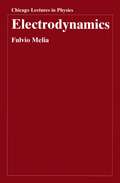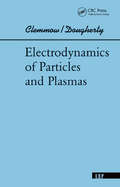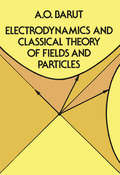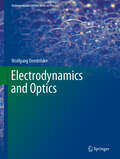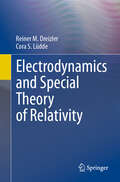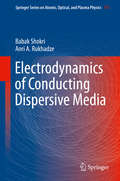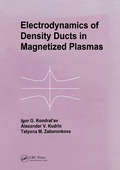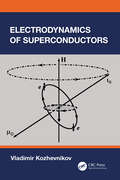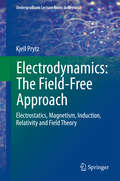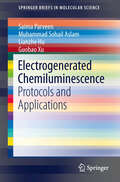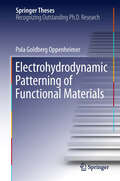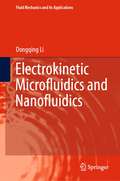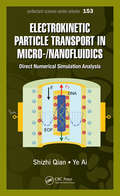- Table View
- List View
Electrodynamics (Chicago Lectures in Physics)
by Fulvio MeliaPractically all of modern physics deals with fields—functions of space (or spacetime) that give the value of a certain quantity, such as the temperature, in terms of its location within a prescribed volume. Electrodynamics is a comprehensive study of the field produced by (and interacting with) charged particles, which in practice means almost all matter. Fulvio Melia's Electrodynamics offers a concise, compact, yet complete treatment of this important branch of physics. Unlike most of the standard texts, Electrodynamics neither assumes familiarity with basic concepts nor ends before reaching advanced theoretical principles. Instead this book takes a continuous approach, leading the reader from fundamental physical principles through to a relativistic Lagrangian formalism that overlaps with the field theoretic techniques used in other branches of advanced physics. Avoiding unnecessary technical details and calculations, Electrodynamics will serve both as a useful supplemental text for graduate and advanced undergraduate students and as a helpful overview for physicists who specialize in other fields.
Electrodynamics Of Particles And Plasmas (Addison-wesley Series In Advanced Physics)
by Phillip C ClemmowFirst Published in 2018. Routledge is an imprint of Taylor & Francis, an Informa company.
Electrodynamics Tutorials with Python Simulations (Series in Computational Physics)
by Minjoon Kouh Taejoon KouhThis book provides an accessible introduction to intermediate-level electrodynamics with computa- tional approaches to complement a traditional mathematical treatment of the subject. It covers key topics in electrodynamics, such as electromagnetic fields, forces, potentials, and waves as well as Special Theory of Relativity.Through intuition-building examples and visualizations in the Python programming language, it helps readers to develop technical computing skills in numerical and symbolic calculations, modeling and simulations, and visualizations. Python is a highly readable and practical programming language, making this book appropriate for students without extensive programming experience.This book can serve as an electrodynamics textbook for undergraduate physics and engineering students in their second or third years, who are studying intermediate- or advanced-level electrodynamics and who want to learn techniques for scientific computing at the same time. This book will also appeal to computer science students who want to see how their computer programming skills may be applied to science, particularly to physics, without needing too much background physics knowledge.Key features• Major concepts in classical electrodynamics are introduced cohesively through computational and mathematical treatments.• Computational examples in Python programming language guide students on how to simulate and visualize electrodynamic principles and phenomena for themselves.Taejoon Kouh is a Professor of Nano and Electronic Physics at Kookmin University, Republic of Korea. He earned his B.A. in physics from Boston University and Sc.M. and Ph.D. degrees in physics from Brown University. After his study in Providence, RI, he returned to Boston, MA, and worked as a postdoctoral research associate in the Department of Aerospace and Mechanical Engineering at Boston University. He is a full faculty member in the Department of Nano and Electronic Physics at Kookmin University in Seoul, Korea, teaching and supervising undergraduate and graduate students. His current research involves the dynamics of nanoelectromechanical systems and the development of fast and reliable transduction methods and innovative applications based on tiny motion.Minjoon Kouh is a program scientist for a philanthropic initiative. He was a Professor of Physics and Neuroscience at Drew University, USA, where he taught more than 30 distinct types of courses. He holds Ph.D. and B.S. degrees in physics from MIT and an M.A. from UC Berkeley. He completed a postdoctoral research fellowship at the Salk Institute for Biological Studies in La Jolla, CA. His research includes computational modeling of the primate visual cortex, information-theoretic analysis of neural responses, machine learning, and pedagogical innovations in undergraduate science education.
Electrodynamics and Classical Theory of Fields and Particles (Dover Books on Physics)
by A. O. Barut"We can only hope that more such striking expositions will be written." -- Bulletin of the American Mathematical SocietyThis is a systematic, covariant treatment of the classical theories of particle motion, fields, and the interaction of fields and particles. Particular attention is given to the interaction of charged particles with the electromagnetic field. The treatment throughout the book is relativistic; the author attempts, as much as possible, a coordinate free (or covariant) form of the equations both for particles and the fields. The book opens with an extensive discussion of space-time, Lorentz transformations, Lorentz-group and tensor and spinor fields. This material is essential to the understanding of many branches of theoretical physics, in particular relativistic quantum theory. Chapter II describes various relativistic forms of the fundamental problem of dynamics: describing the trajectories of particles for given external forces. The general dynamical principles to obtain the field equations and the important problems of the conservation laws are discussed in Chapter III. The second part of the book (Chapters IV-VI) is devoted to a lucid treatment of the interactions of fields and particles. Chapter IV deals with equations of motion and their solutions (the so-called Cauchy problem), focusing on the solution of field equations with Green's functions using Dirac formalism. The problem of feedback between particles and fields (radiation and radiation reaction) is taken up in Chapter V, as are questions concerning the limitations of classical field theories and classical dynamics. Dr. Barut concludes the book with an excellent exposition of the purely mechanical approach to the problem of the interactions of charged particles -- the so-called action-at-a-distance formulation of electrodynamics. Problems, alternate proofs, and additional topics are included at the end of each chapter, where a useful bibliography is also provided. A general bibliography appears at the end of the book.
Electrodynamics and Optics (Undergraduate Lecture Notes in Physics)
by Wolfgang DemtröderThis engaging text offers an accessible and clear treatment of the fundamentals of electromagnetics and optics, a core part of the standard undergraduate physics curriculum. Starting with static electric and magnetic fields, the book works through electromagnetic oscillations and the formation and propagation of electromagnetic waves, before moving on to geometric and wave optics, optical instrumentation and some discussion of new technologies in optics. The text is written from the experimental physics point of view, giving numerous real life examples and applications of devices. This highly motivating presentation deepens the knowledge in a very accessible way, carefully interweaving theory and practical applications. Students are guided through the material with well-chosen examples and case studies, and helpful chapter summaries are provided together with numerous exercises and detailed solutions, all intended to motivate and develop a well-founded understanding of the subject matter.
Electrodynamics and Special Theory of Relativity
by Reiner M. Dreizler Cora S. LüddeThis textbook offers you a profound understanding of the core concepts in electrodynamics and the special theory of relativity. Emphasis is placed on establishing strong mathematical fundamentals while also equipping you with problem-solving skills crucial for mastering these disciplines. It covers electromagnetic theory, encompassing Maxwell's equations and electromagnetic wave theory as well as special theory of relativity, including space-time principles and the Lorentz transformation.
Electrodynamics of Conducting Dispersive Media (Springer Series on Atomic, Optical, and Plasma Physics #111)
by Babak Shokri Anri A. RukhadzeThis book presents a sequential representation of the electrodynamics of conducting media with dispersion. In addition to the general electrodynamic formalism, specific media such as classical nondegenerate plasma, degenerate metal plasma, magnetoactive anisotropic plasma, atomic hydrogen gas, semiconductors, and molecular crystals are considered.The book draws on such classics as Electrodynamics of plasma and plasma-like media (Silin and Rukhadze) and Principles of Plasma Electrodynamics (Alexandrov, Bogdankevich, and Rukhadze), yet its outlook is thoroughly modern—both in content and presentation, including both classical and quantum approaches. It explores such recent topics as surface waves on thin layers of plasma and non-dispersive media, the permittivity of a monatomic gas with spatial dispersion, and current-driven instabilities in plasma, among many others. Each chapter is equipped with a large number of problems with solutions that have academic and practical importance. This book will appeal to graduate students as well as researchers and other professionals due to its straight-forward yet thorough treatment of electrodynamics in conducting dispersive media.
Electrodynamics of Density Ducts in Magnetized Plasmas: The Mathematical Theory of Excitation and Propagation of Electromagnetic Waves in Plasma Waveguides
by I G Kondratiev A V Kudrin T M ZaboronkovaProviding a systematic and self-contained treatment of excitation, propagation and re- emission of electromagnetic waves guided by density ducts in magnetized plasmas, this book describes in detail the theoretical basis of the electrodynamics of ducts. The classical dielectric-waveguide theory in open guiding systems in magnetoplasma is subjected to rigorous generalization. The authors emphasize the conceptual physical and mathematical aspects of the theory, while demonstrating its applications to problems encountered in actual practice. The opening chapters of the book discuss the underlying physical phenomena, outline some of the results obtained in natural and artificial density ducts, and describe the basic theory crucial to understanding the remainder of the book. The more specialized and complex topics dealt with in subsequent chapters include the theory of guided wave propagation along axially uniform ducts, finding the field excited by the source in the presence of a duct, excitation of guided modes, the asymptotic theory of wave propagation along axially nonuniform ducts, and mode re-emission from a duct. The full wave theory is used throughout most of the book to ensure consistency, and the authors start with simpler cases and gradually increase the complexity of the treatment.
Electrodynamics of Superconductors
by Vladimir KozhevnikovSuperconductivity is a remarkable, on the verge of miraculous, macroscopic quantum phenomenon with a boundless potential for a wide variety of applications. Over the last century the physics of superconductivity constitutes a major part of research in condensed matter and yet the electrodynamics of superconductors appears as only a minor part in textbooks on electrodynamics and superconductivity. The book offers a fresh look at electrodynamics of continuous media with detailed description of thermal and electromagnetic properties of superconductors, emphasising physical meaning of concepts and principles without excessive mathematics. To facilitate understanding, it is accompanied by problems and worked solutions. The book will be of interest to senior undergraduate and graduate students of physics and chemistry who have taken a calculus-based course in general physics. It is a valuable reference for researchers involved in studies of superconductivity, the physics of metals, and condensed matter physics.Key Features: The first book - in terms of semi-classical physics - addressing both equilibrium and nonequilibrium, thermal and transport properties of superconducting materials Presents an accessible overview without excessive mathematics Accompanied by problems with solutions to aid understanding
Electrodynamics: The Field-Free Approach
by Kjell PrytzThis book is intended as an undergraduate textbook in electrodynamics at basic or advanced level. The objective is to attain a general understanding of the electrodynamic theory and its basic experiments and phenomena in order to form a foundation for further studies in the engineering sciences as well as in modern quantum physics. The outline of the book is obtained from the following principles: * Base the theory on the concept of force and mutual interaction * Connect the theory to experiments and observations accessible to the student * Treat the electric, magnetic and inductive phenomena cohesively with respect to force, energy, dipoles and material * Present electrodynamics using the same principles as in the preceding mechanics course * Aim at explaining that theory of relativity is based on the magnetic effect * Introduce field theory after the basic phenomena have been explored in terms of force Although electrodynamics is described in this book from its 1st principles, prior knowledge of about one semester of university studies in mathematics and physics is required, including vector algebra, integral and differential calculus as well as a course in mechanics, treating Newton's laws and the energy principle. The target groups are physics and engineering students, as well as professionals in the field, such as high school teachers and employees in the telecom industry. Chemistry and computer science students may also benefit from the book.
Electrogenerated Chemiluminescence (Monographs In Electroanalytical Chemistry And Electrochemistry Ser.)
by Allen J. BardThe first source on this expanding analytical science, this reference explores advances in the instrumentation, design, and application of techniques with electrogenerated chemiluminescence (ECL), examining the use and impact of ECL-based assays in clinical diagnostics, life science research, environmental testing, food and water evaluation, and th
Electrogenerated Chemiluminescence: Protocols and Applications
by Guobao Xu Lianzhe Hu Muhammad Sohail Aslam Saima ParveenThis book primarily focuses on the fundamentals of and new developments in electrochemiluminescence (ECL), presenting high-quality content and explicitly aiming to summarize and disseminate the current state-of-the-art. The topics covered include the fundamental theory, mechanism, types of reactions involved, and the instrumental techniques. The book also examines the applications of ECL in many of the emerging fields of science, such as bioanalytical, analytical, clinical, pharmaceutical, forensic, military, microchip, µTAS, and LED. It will be invaluable to bioanalysts, drug analysts, pharmaceutical researchers and other professionals worldwide, as well as to other interested readers.
Electrohydrodynamic Patterning of Functional Materials
by Pola Goldberg OppenheimerThis thesis explores a route to induce and control the structure formation process in thin films by the use of strong electric fields. We investigate, establish and apply the use of the electrohydrodynamic (EHD) lithography as a versatile patterning tool on the sub-micrometre and nanometre length scales for functional materials. Thin films are ubiquitous, they are found in nature and used in almost every aspect of daily life. While film instabilities are often undesirable in nature and technology, they can be utilized to produce structures by precisely controlling the destabilization of the film. EHD lithography utilizes instabilities induced by means of an electric field to fabricate periodic structures. EHD patterning is set to become a competitive candidate for low-cost lithographic technology for a number of applications. Herein, the applied potential of this lithographic process is explored by expanding its applicability to a broad range of materials and by a simultaneous patterning of multilayer systems or functional polymers yielding hierarchical architectures with novel functionalities. EHD pattern formation enables for instance, the fabrication of multi-scale structured arrays as surface enhanced Raman scattering (SERS)-active platforms. Furthermore, crystalline and conductive polymers are patterned using the EHD approach and the underlying structure formation mechanisms are discussed. This extension towards functional material systems offers interesting prospects for potential applications. Findings of this thesis are very promising for use in optoelectronic devices.
Electroinduced Drift of Neutral Charge Clusters in Salt Solutions
by M. A. Kazaryan Li Hunda I.V. ShamaninElectroinduced Drift of Neutral Charge Clusters in Salt Solutions presents studies of the processes accompanying the effect of periodic electric and magnetic fields on salt solutions in polar dielectric liquids. The authors explain phenomena from a physical point of view, without theoretical constructions and mathematical calculations. This is done in order to make the book accessible to a wide audience and to help the reader navigate in a multilateral topic that is touched upon when studying processes that occur in liquid media under the external influence of an electromagnetic nature. Additional Features: Explores the phenomenon of selective drift of solvated ions in polar dielectric liquids Applies general principles of electricity and magnetism to describe experimental results Demonstrates how small perturbations of the equilibrium distribution determine not the corrections to the effects but the effects themselves Approaches nonequilibrium molecular physics as a science of physical and chemical processes This book will be useful to specialists, engineers and graduate students, especially those recording and transmitting information in liquid media.
Electrokinetic Microfluidics and Nanofluidics (Fluid Mechanics and Its Applications #133)
by Dongqing LiThis book reviews the latest advancement of microfluidics and nanofluidics with a focus on electrokinetic phenomena in microfluidics and nanofluidics. It provides fundamental understanding of several new interfacial electrokinetic phenomena in microfluidics and nanofluidics. Chapter 1 gives a brief review of the fundamentals of interfacial electrokinetics. Chapter 2 shows induced charge electrokinetic transport phenomena. Chapter 3 presents the new advancement in DC dielectrophoresis. Chapter 4 introduces a novel nanofabrication method and the systematic studies of electrokinetic nanofluidics. Chapter 5 presents electrokinetic phenomena associated with Janus particles and Janus droplets. Chapter 6 introduces a new direction of electrokinetic nanofluidics: nanofluidic iontronics. Chapter 7 discusses an important differential resistive pulse sensor in microfluidics and nanofluidics.
Electrokinetic Particle Transport in Micro-/Nanofluidics: Direct Numerical Simulation Analysis (Surfactant Science)
by Shizhi Qian Ye AiNumerous applications of micro-/nanofluidics are related to particle transport in micro-/nanoscale channels, and electrokinetics has proved to be one of the most promising tools to manipulate particles in micro/nanofluidics. Therefore, a comprehensive understanding of electrokinetic particle transport in micro-/nanoscale channels is crucial to the
Electrokinetic Phenomena: Principles and Applications in Analytical Chemistry and Microchip Technology
by Anurag S. Rathore András GuttmanElectrokinetic Phenomena emphasizes the impact of methods such as capillary zone electrophoresis, capillary electrochromatography, and capillary gel electrophoresis on the analysis of biomolecules. This reference reveals the electrokinetic phenomena that underlie high-performance electro-based analytical tools and vividly depicts how electro
Electrokinetic Remediation for Environmental Security and Sustainability
by Alexandra B. Ribeiro Majeti Narasimha Vara PrasadExplore this comprehensive reference on the remediation of contaminated substrates, filled with cutting-edge research and practical case studies Electrokinetic Remediation for Environmental Security and Sustainability delivers a thorough review of electrokinetic remediation (EKR) for the treatment of inorganic and organic contaminants in contaminated substrates. The book highlights recent progress and developments in EKR in the areas of resource recovery, the removal of pollutants, and environmental remediation. It also discusses the use of EKR in conjunction with nanotechnology and phytoremediation. Throughout the book, case studies are presented that involve the field implementation of EKR technologies. The book also includes discussions of enhanced electrokinetic remediation of dredged co-contaminated sediments, solar-powered bioelectrokinetics for the mitigation of contaminated agricultural soil, advanced electro-fenton for remediation of organics, electrokinetic remediation for PPCPs in contaminated substrates, and the electrokinetic remediation of agrochemicals such as organochlorine compounds. Other topics include: A thorough introduction to the modelling of electrokinetic remediation An exploration of the electrokinetic recovery of tungsten and removal of arsenic from mining secondary resources An analysis of pharmaceutically active compounds in wastewater treatment plants with a discussion of electrochemical advanced oxidation as an on-site treatment A review of rare earth elements, including general concepts and recovery techniques, like electrodialytic extraction A treatment of hydrocarbon-contaminated soil in cold climate conditions Perfect for environmental engineers and scientists, geologists, chemical engineers, biochemical engineers, and scientists working with green technology, Electrokinetic Remediation for Environmental Security and Sustainability will also earn a place in the libraries of academic and industry researchers, engineers, regulators, and policy makers with an interest in the remediation of contaminated natural resources.
Electrokinetics for Petroleum and Environmental Engineers
by George V. Chilingar Mohammed HarounElectrokinetics is a term applied to a group of physicochemical phenomena involving the transport of charges, action of charged particles, effects of applied electric potential and fluid transport in various porous media to allow for a desired migration or flow to be achieved. These phenomena include electrokinetics, electroosmosis, ion migration, electrophoresis, streaming potential and electroviscosity. These phenomena are closely related and all contribute to the transport and migration of different ionic species and chemicals in porous media. The physicochemical and electrochemical properties of a porous medium and the pore fluid, and the magnitudes of the applied electrical potential all impact the direction and velocity of the fluid flow. Also, an electrical potential is generated upon the forced passage of fluid carrying charged particles through a porous medium. The use of electrokinetics in the field of petroleum and environmental engineering was groundbreaking when George Chilingar pioneered its use decades ago, but it has only been in recent years that its full potential has been studied. This is the first volume of its kind ever written, offering the petroleum or environmental engineer a practical "how to" book on using electrokinetics for more efficient and better oil recovery and recovery from difficult reservoirs. This groundbreaking volume is a must-have for any petroleum engineer working in the field, and for students and faculty in petroleum engineering departments worldwide.
Electrolytes for Electrochemical Supercapacitors (Electrochemical Energy Storage and Conversion)
by Jiujun Zhang Jinli Qiao Cheng Zhong Yida Deng Wenbin Hu Daoming Sun Xiaopeng HanElectrolytes for Electrochemical Supercapacitors provides a state-of-the-art overview of the research and development of novel electrolytes and electrolyte configurations and systems to increase the energy density of electrochemical supercapacitors. Comprised of chapters written by leading international scientists active in supercapacitor research
Electrolytes for Lithium and Lithium-Ion Batteries
by T. Richard Jow Kang Xu Oleg Borodin Makoto UeElectrolytes for Lithium and Lithium-ion Batteries provides a comprehensive overview of the scientific understanding and technological development of electrolyte materials in the last several years. This book covers key electrolytes such as LiPF6 salt in mixed-carbonate solvents with additives for the state-of-the-art Li-ion batteries as well as new electrolyte materials developed recently that lay the foundation for future advances This book also reviews the characterization of electrolyte materials for their transport properties, structures, phase relationships, stabilities, and impurities. The book discusses in-depth the electrode-electrolyte interactions and interphasial chemistries that are key for the successful use of the electrolyte in practical devices. The Quantum Mechanical and Molecular Dynamical calculations that has proved to be so powerful in understanding and predicating behavior and properties of materials is also reviewed in this book. Electrolytes for Lithium and Lithium-ion Batteries is ideal for electrochemists, engineers, researchers interested in energy science and technology, material scientists, and physicists working on energy.
Electrolytes: Supramolecular Interactions and Non-Equilibrium Phenomena in Concentrated Solutions
by Georgii Georgievich AseyevElectrolyte solutions play a key role in traditional chemical industry processes as well as other sciences such as hydrometallurgy, geochemistry, and crystal chemistry. Knowledge of electrolyte solutions is also key in oil and gas exploration and production, as well as many other environmental engineering endeavors. Until recently, a gap existed be
Electrolytic Production of Al–Si Alloys: Theory and Technology (Monographs in Electrochemistry)
by Dmitriy Pruttskov Aleksander Andriiko Aleksei KirichenkoThis monograph presents the theoretical background of the industrial process for the production of Al-Si alloys in standard aluminum electrolyzers. It reviews the physical chemistry and electrochemistry of cryolite melts containing silica and focuses on analyzing the exchange reactions in Na3AlF6–Al2O3–SiO2 melts. It presents the kinetics and mechanism of Si(IV) electroreduction in Na3AlF6–Al2O3–SiO2 melts on Al cathodes while the current yields as well as industrial tests performed are discussed. The modern research trends in the field are also overviewed. Providing readers with information not easily obtained in any other single source, this book is of great interest to researchers, graduates, and professionals working in the fields of electrochemistry and technology of cryolite-based melts.
Electrolyzed Water in Food: Fundamentals And Applications
by Tian Ding Deog-Hwan Oh Donghong LiuThis book provides fundamentals, highlights recent developments and offers new perspectives relating to the use of electrolyzed water (EW) as an emerging user- and environmental-friendly broad-spectrum sanitizer, with particular focus on the food industry. It addresses the generation, inactivation, pesticide degradation and safety of food by EW, illustrates the mechanism of the germicidal action of EW and its antimicrobial efficacy against a variety of microorganisms in suspensions. In addition, the sanitizing effects of combining EW with various chemical and physical sanitizing technologies have been evaluated, and recent developments and applications of EW in various areas including fruits and vegetables, meat, aquatic products, environment sterilization, livestock and agriculture has been described. The book can be a go-to reference book of EW for: (1) Researchers who need to understand the role of various parameters in its generation, the bactericidal mechanism of EW and its wide applications for further research and development; (2) Equipment producers who need comprehensive understanding of various factors (e.g. type of electrolyte, flow rates of water and electrolyte) which govern the efficacy of EW and developing its generators; (3) Food processors who need good understanding of EW in order to implement it in the operations and supervisors who need to balance the advantages and limitations of EW and ensuring its safe use.
Electromagnetic Acoustic Transducers
by Masahiko Hirao Hirotsugu OgiThis second edition provides comprehensive information on electromagnetic acoustic transducers (EMATs), from the theory and physical principles of EMATs to the construction of systems and their applications to scientific and industrial ultrasonic measurements on materials. The original version has been complemented with selected ideas on ultrasonic measurement that have emerged since the first edition was released. The book is divided into four parts: PART I offers a self-contained description of the basic elements of coupling mechanisms along with the practical designing of EMATs for various purposes. Several implementations to compensate for EMATs' low transfer efficiency are provided, along with useful tips on how to make an EMAT. PART II describes the principle of electromagnetic acoustic resonance (EMAR), which makes the most of EMATs' contactless nature and is the most successful amplification mechanism for precise measurements of velocity and attenuation. PART III applies EMAR to studying physical acoustics. New measurements have emerged with regard to four major subjects: in situ monitoring of dislocation behavior, determination of anisotropic elastic constants, pointwise elasticity mapping (RUM), and acoustic nonlinearity evolution. PART IV deals with a variety of individual issues encountered in industrial applications, for which the EMATs are believed to be the best solutions. This is proven by a number of field applications.
